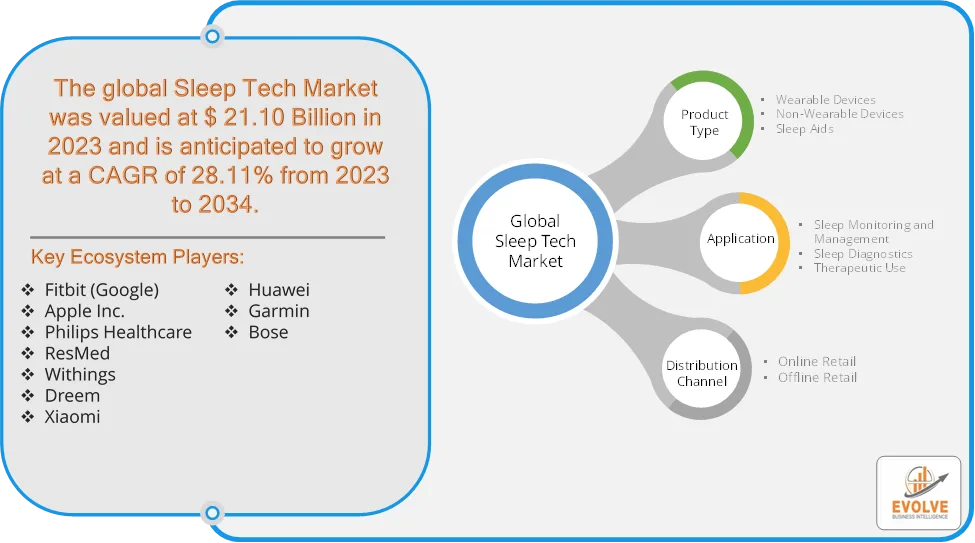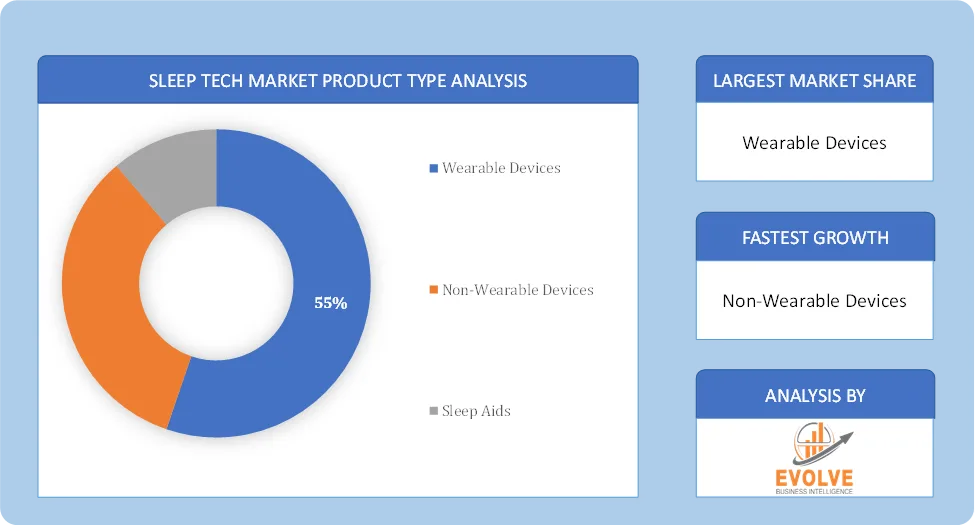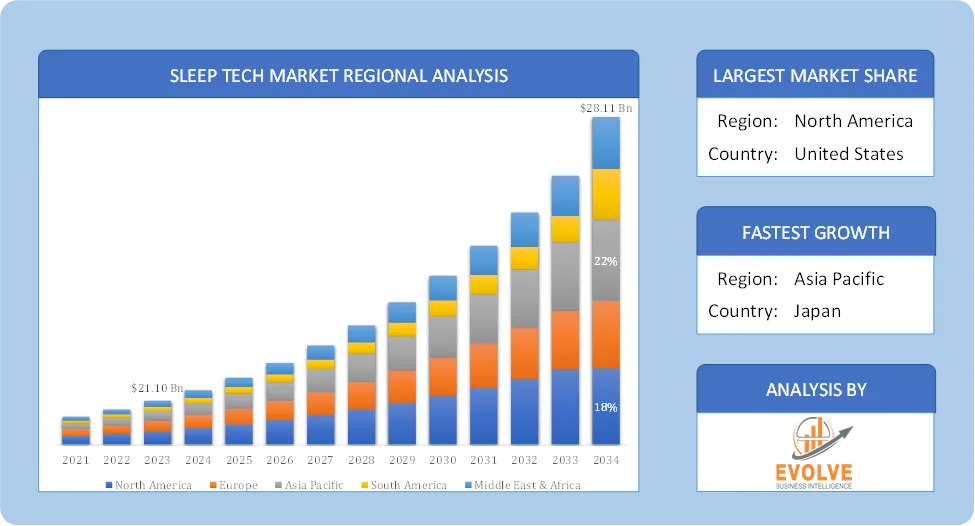Sleep Tech Market Analysis and Global Forecast 2024-2034
$ 1,390.00 – $ 5,520.00Price range: $ 1,390.00 through $ 5,520.00
Sleep Tech Market Research Report: Information By Product Type (Wearable Devices, Non-Wearable Devices, Sleep Aids), By Application (Sleep Monitoring and Management, Sleep Diagnostics, Therapeutic Use), By Distribution Channel (Online Retail, Offline Retail), and by Region — Forecast till 2034
Page: 129
Sleep Tech Market Overview
The Sleep Tech Market size accounted for USD 21.10 Billion in 2023 and is estimated to account for 23.69 Billion in 2024. The Market is expected to reach USD 28.11 Billion by 2034 growing at a compound annual growth rate (CAGR) of 18.32% from 2024 to 2034. The Sleep Tech Market is experiencing significant growth due to increasing awareness about sleep disorders, advancements in wearable and non-wearable sleep technologies, and a rising demand for sleep monitoring solutions. Sleep technology includes devices and applications designed to track, analyze, and improve sleep patterns, addressing issues like insomnia, sleep apnea, and overall sleep quality.
The sleep tech market is dynamic and rapidly evolving, with significant potential for growth. Innovations in wearable sleep trackers, smart beds, and AI-driven sleep monitoring systems are enhancing sleep analysis and personalized recommendations.
Global Sleep Tech Market Synopsis
 Sleep Tech Market Dynamics
Sleep Tech Market Dynamics
The major factors that have impacted the growth of Sleep Tech Market are as follows:
Drivers:
Ø Rising Prevalence of Sleep Disorders
Conditions like insomnia, obstructive sleep apnea (OSA), restless leg syndrome (RLS), and narcolepsy are increasing globally. The World Sleep Society reports that nearly 45% of the world’s population suffers from sleep-related problems, creating a strong demand for sleep tech solutions. Wearable Sleep Trackers – Smartwatches and fitness bands (e.g., Fitbit, Apple Watch) now integrate advanced sleep tracking features using AI and biometrics. Non-Wearable Solutions – Smart beds, sensors, and IoT-based sleep monitors analyze sleep patterns without requiring physical contact and AI and Machine Learning – AI-driven sleep analytics offer personalized insights and recommendations.
Restraint:
- High Cost of Sleep Tech Products and Data Security Concerns
Advanced sleep monitoring devices, smart beds, CPAP machines, and AI-driven sleep solutions are often expensive, limiting adoption among price-sensitive consumers. Subscription-based sleep apps and analytics services also add to the cost, making long-term use less affordable for some users. Sleep tech devices collect sensitive biometric and behavioral data, raising concerns about data security and user privacy and unauthorized data sharing and cybersecurity risks can discourage consumers from using sleep tracking devices and apps.
Opportunity:
⮚ Growing Demand for AI-Driven Sleep Solutions
The use of AI and machine learning in sleep analysis offers personalized sleep recommendations based on real-time data. AI-powered smart alarms, sleep coaching apps, and adaptive sleep environments present major business opportunities. Sleep tech integration with smart home ecosystems (e.g., Amazon Alexa, Google Home, Apple HomeKit) is creating demand for Smart beds with temperature and firmness control, IoT-enabled sleep monitoring systems and AI-driven sleep assistants that adjust lighting, temperature, and sounds for better sleep. Wearable devices like smartwatches, fitness bands, and smart rings are gaining popularity for continuous sleep tracking and Opportunity for innovation in wearable sensors for non-intrusive sleep monitoring.
Sleep Tech Market Segment Overview
Based on Product Type, the market is segmented based on Wearable Devices, Non-Wearable Devices, Sleep Aids. Wearable devices dominate the market due to their convenience and integration with existing consumer electronics. The segment is growing as more consumers prioritize health, leveraging biometric monitoring for better sleep patterns. The demand for wearable technology is increasing due to rising awareness about sleep-related health issues and advancements in sensor technology.
By Application
Based on Application, the market segment has been divided into Sleep Monitoring and Management, Sleep Diagnostics, Therapeutic Use. The sleep monitoring and management segment dominant the market, driven by the increasing adoption of smart sensors, AI-based diagnostics, and connected sleep ecosystems. Companies like Withings and SleepScore Labs offer clinically validated monitoring solutions that provide users with comprehensive sleep insights.
By Distribution Channel
Based on Distribution Channel, the market segment has been divided into Online Retail, Offline Retail. Online Retail segment dominant the market. Online platforms are the primary distribution channels for tech products due to their accessibility and convenience. E-commerce giants like Amazon and dedicated health-tech platforms have seen a surge in sleep tech product sales.
Global Sleep Tech Market Regional Analysis
Based on region, the global Sleep Tech Market has been divided into North America, Europe, Asia-Pacific, the Middle East & Africa, and Latin America. North America is projected to dominate the use of the Sleep Tech Market followed by the Asia-Pacific and Europe regions.
 North America Sleep Tech Market
North America Sleep Tech Market
North America holds a dominant position in the Sleep Tech Market. North America, particularly the United States, holds a significant market share. This is attributed to high consumer awareness of sleep disorders, advanced healthcare infrastructure, and a strong presence of key market players and the U.S. leads due to strong support from healthcare providers and insurers promoting monitoring solutions. Growing demand for wearable sleep tracking devices and increasing adoption of CPAP machines & remote sleep monitoring solutions for medical use.
Asia-Pacific Sleep Tech Market
The Asia-Pacific region has indeed emerged as the fastest-growing market for the Sleep Tech Market industry. It’s driven by factors like rising healthcare expenditure, increasing lifestyle diseases, and growing adoption of wearable devices. China and India are identified as highly lucrative markets. Expanding middle-class population with higher spending power and rising investments in sleep-focused startups & wellness tech.
Competitive Landscape
The global Sleep Tech Market is highly competitive, with numerous players offering a wide range of software solutions. The competitive landscape is characterized by the presence of established companies, as well as emerging startups and niche players. To increase their market position and attract a wide consumer base, the businesses are employing various strategies, such as product launches, and strategic alliances.
Prominent Players:
- Fitbit (Google)
- Apple Inc.
- Philips Healthcare
- ResMed
- Withings
- Dreem
- Xiaomi
- Huawei
- Garmin
Key Development
In September 2024, ResMed unveiled a new collection of digital and personalized solutions to improve sleep health. They announced an advanced AI-driven CPAP device with real-time monitoring features, leveraging cloud-based analytics to enhance treatment personalization.
In November 2024, Fitbit (Google) teased a new sleep stage feature on their Instagram account, indicating ongoing developments in their sleep-tracking capabilities.
Scope of the Report
Global Sleep Tech Market, by Product Type
- Wearable Devices
- Non-Wearable Devices
- Sleep Aids
Global Sleep Tech Market, by Application
- Sleep Monitoring and Management
- Sleep Diagnostics
- Therapeutic Use
Global Sleep Tech Market, by Distribution Channel
- Online Retail
- Offline Retail
Global Sleep Tech Market, by Region
- North America
- US
- Canada
- Mexico
- Europe
- UK
- Germany
- France
- Italy
- Spain
- Benelux
- Nordic
- Rest of Europe
- Asia Pacific
- China
- Japan
- South Korea
- Indonesia
- Austalia
- Malaysia
- India
- Rest of Asia Pacific
- South America
- Brazil
- Argentina
- Rest of South America
- Middle East & Africa
- Saudi Arabia
- UAE
- Egypt
- South Africa
- Rest of Middle East & Africa
| Parameters | Indicators |
|---|---|
| Market Size | 2034: USD 28.11 Billion |
| CAGR (2024-2034) | 18.32% |
| Base year | 2022 |
| Forecast Period | 2024-2034 |
| Historical Data | 2021 (2017 to 2020 On Demand) |
| Report Coverage | Revenue Forecast, Competitive Landscape, Growth Factors, and Trends |
| Key Segmentations | Product Type, Application, Distribution Channel |
| Geographies Covered | North America, Europe, Asia-Pacific, South America, Middle East, Africa |
| Key Vendors | Fitbit (Google), Apple Inc., Philips Healthcare, ResMed, Withings, Dreem, Xiaomi, Huawei, Garmin and Bose. |
| Key Market Opportunities | · Growing Demand for AI-Driven Sleep Solutions
· Rise of Wearable Sleep Tech |
| Key Market Drivers | · Rising Prevalence of Sleep Disorders
· Technological Advancements |
REPORT CONTENT BRIEF:
- High-level analysis of the current and future Sleep Tech Market trends and opportunities
- Detailed analysis of current market drivers, restraining factors, and opportunities in the future
- Sleep Tech Market historical market size for the year 2021, and forecast from 2023 to 2033
- Sleep Tech Market share analysis at each product level
- Competitor analysis with detailed insight into its product segment, Government & Defense strength, and strategies adopted.
- Identifies key strategies adopted including product launches and developments, mergers and acquisitions, joint ventures, collaborations, and partnerships as well as funding taken and investment done, among others.
- To identify and understand the various factors involved in the global Sleep Tech Market affected by the pandemic
- To provide a detailed insight into the major companies operating in the market. The profiling will include the Government & Defense health of the company’s past 2-3 years with segmental and regional revenue breakup, product offering, recent developments, SWOT analysis, and key strategies.
Frequently Asked Questions (FAQ)
What is the study period of this market?
The study period of the global Sleep Tech Market is 2021- 2033
What is the growth rate of the global Sleep Tech Market?
The global Sleep Tech Market is growing at a CAGR of 18.32% over the next 10 years
Which region has the highest growth rate in the market of Sleep Tech Market?
Asia Pacific is expected to register the highest CAGR during 2024-2034
Which region has the largest share of the global Sleep Tech Market?
North America holds the largest share in 2022
Who are the key players in the global Sleep Tech Market?
Fitbit (Google), Apple Inc., Philips Healthcare, ResMed, Withings, Dreem, Xiaomi, Huawei, Garmin and Bose. are the major companies operating in the market.
Do you offer Post Sale Support?
Yes, we offer 16 hours of analyst support to solve the queries
Do you sell particular sections of a report?
Yes, we provide regional as well as country-level reports. Other than this we also provide a sectional report. Please get in contact with our sales representatives.
Press Release

Global Pharmaceutical Manufacturing Market to Reach $1.38 Trillion by 2035 with 7.35% CAGR, New Research Shows

The Global Mammography Market Is Estimated To Record a CAGR of Around 10.29% During The Forecast Period

Glue Stick Market to Reach USD 2.35 Billion by 2034

Podiatry Service Market to Reach USD 11.88 Billion by 2034

Microfluidics Technology Market to Reach USD 32.58 Billion by 2034

Ferric Chloride Market to Reach USD 10.65 Billion by 2034

Family Practice EMR Software Market to Reach USD 21.52 Billion by 2034

Electric Hairbrush Market to Reach USD 15.95 Billion by 2034

Daily Bamboo Products Market to Reach USD 143.52 Billion by 2034

Cross-border E-commerce Logistics Market to Reach USD 112.65 Billion by 2034
Table of Contents
CHAPTER 1. Executive Summary
CHAPTER 2. Scope of the Study
2.1. Market Definition
2.2. Market Scope & Segmentation
2.2.1. Objective of Report
CHAPTER 3. Evolve BI Methodology
3.1. Data Collection & Validation Approach
3.2. Market Size Estimation and Forecast
CHAPTER 4. Exclusive Analysis
4.1. Market Opportunity Score
4.1.1. Product Type Segement – Market Opportunity Score
4.1.2. Application Segment – Market Opportunity Score
4.1.3. Distribution Channel Segment – Market Opportunity Score
4.2. Key Market Influencing Indicators
CHAPTER 5. Market Insights and Trends
5.1. Value Chain Analysis
5.1.1. Raw Material
5.1.2. Manufacturing Process
5.1.3. Distribution Channel
5.1.4. End User
5.2. Porter’s Five Forces Analysis
5.2.1. Bargaining Power of Buyers
5.2.2. Bargaining Power of Suppliers
5.2.3. Threat of New Entrant
5.2.4. Threat of Substitute
5.2.5. Industry Rivalry
5.3. COVID-19 Impact and Post COVID Scenario on Sleep Tech Market
5.3.1. Impact of COVID-19
5.3.2. Government Support and Industry Revival Policies
5.3.3. Measures Taken by Companies to Mitigate Negative Impact
5.3.4. Post COVID Trend
CHAPTER 6. Market Dynamics
6.1. Introduction
6.2. Drivers
6.2.1. Driver 1
6.2.2. Driver 2
6.2.3. Driver 3
6.3. Restraints
6.3.1. Restraint 1
6.3.2. Restraint 2
6.4. Opportunity
6.4.1. Opportunity 1
CHAPTER 7. Sleep Tech Market, By Product Type
7.1. Introduction
7.1.1. Wearable Devices
7.1.2 Non-Wearable Devices
7.1.3 Sleep Aids
CHAPTER 8 Sleep Tech Market, By Application
8.1. Introduction
8.1.1. Sleep Monitoring and Management
8.1.2. Sleep Diagnostics
8.1.3. Therapeutic Use
CHAPTER 9. Sleep Tech Market, By Distribution Channel
9.1. Introduction
9.1.1. Online Retail
9.1.2. Offline Retail
CHAPTER 10. Sleep Tech Market, By Region
10.1. Introduction
10.2. NORTH AMERICA
10.2.1. North America: Market Size and Forecast, By Country, 2024 – 2034($ Million)
10.2.2. North America: Market Size and Forecast, By Product Type, 2024 – 2034($ Million)
10.2.3. North America: Market Size and Forecast, By Application, 2024 – 2034($ Million)
10.2.4. North America: Market Size and Forecast, By Distribution Channel, 2024 – 2034($ Million)
10.2.5. US
10.2.5.1. US: Market Size and Forecast, By Product Type, 2024 – 2034($ Million)
10.2.5.2. US: Market Size and Forecast, By Application, 2024 – 2034($ Million)
10.2.5.3. US: Market Size and Forecast, By Distribution Channel, 2024 – 2034($ Million)
10.2.6. CANADA
10.2.6.1. Canada: Market Size and Forecast, By Product Type, 2024 – 2034($ Million)
10.2.6.2. Canada: Market Size and Forecast, By Application, 2024 – 2034($ Million)
10.2.6.3. Canada: Market Size and Forecast, By Distribution Channel, 2024 – 2034($ Million)
10.2.7. MEXICO
10.2.7.1. Mexico: Market Size and Forecast, By Product Type, 2024 – 2034($ Million)
10.2.7.2. Mexico: Market Size and Forecast, By Application, 2024 – 2034($ Million)
10.2.7.3. Mexico: Market Size and Forecast, By Distribution Channel, 2024 – 2034($ Million)
10.3. Europe
10.3.1. Europe: Market Size and Forecast, By Country, 2024 – 2034($ Million)
10.3.2. Europe: Market Size and Forecast, By Product Type, 2024 – 2034($ Million)
10.3.3. Europe: Market Size and Forecast, By Application, 2024 – 2034($ Million)
10.3.4. Europe: Market Size and Forecast, By Distribution Channel, 2024 – 2034($ Million)
10.3.5. U.K.
10.3.5.1. U.K.: Market Size and Forecast, By Product Type, 2024 – 2034($ Million)
10.3.5.2. U.K.: Market Size and Forecast, By Application, 2024 – 2034($ Million)
10.3.5.3. U.K.: Market Size and Forecast, By Distribution Channel, 2024 – 2034($ Million)
10.3.6. GERMANY
10.3.6.1. Germany: Market Size and Forecast, By Product Type, 2024 – 2034($ Million)
10.3.6.2. Germany: Market Size and Forecast, By Application, 2024 – 2034($ Million)
10.3.6.3. Germany: Market Size and Forecast, By Distribution Channel, 2024 – 2034($ Million)
10.3.7. FRANCE
10.3.7.1. France: Market Size and Forecast, By Product Type, 2024 – 2034($ Million)
10.3.7.2. France: Market Size and Forecast, By Application, 2024 – 2034($ Million)
10.3.7.3. France: Market Size and Forecast, By Distribution Channel, 2024 – 2034($ Million)
10.3.8. ITALY
10.3.8.1. Italy: Market Size and Forecast, By Product Type, 2024 – 2034($ Million)
10.3.8.2. Italy: Market Size and Forecast, By Application, 2024 – 2034($ Million)
10.3.8.3. Italy: Market Size and Forecast, By Distribution Channel, 2024 – 2034($ Million)
10.3.9. SPAIN
10.3.9.1. Spain: Market Size and Forecast, By Product Type, 2024 – 2034($ Million)
10.3.9.2. Spain: Market Size and Forecast, By Application, 2024 – 2034($ Million)
10.3.9.3. Spain: Market Size and Forecast, By Distribution Channel, 2024 – 2034($ Million)
10.3.10. BENELUX
10.3.10.1. BeNeLux: Market Size and Forecast, By Product Type, 2024 – 2034($ Million)
10.3.10.2. BeNeLux: Market Size and Forecast, By Application, 2024 – 2034($ Million)
10.3.10.3. BeNeLux: Market Size and Forecast, By Distribution Channel, 2024 – 2034($ Million)
10.3.11. RUSSIA
10.3.11.1. Russia: Market Size and Forecast, By Product Type, 2024 – 2034($ Million)
10.3.11.2. Russia: Market Size and Forecast, By Application, 2024 – 2034($ Million)
10.3.11.3. Russia: Market Size and Forecast, By Distribution Channel, 2024 – 2034($ Million)
10.3.12. REST OF EUROPE
10.3.12.1. Rest of Europe: Market Size and Forecast, By Product Type, 2024 – 2034($ Million)
10.3.12.2. Rest of Europe: Market Size and Forecast, By Application, 2024 – 2034($ Million)
10.3.12.3. Rest of Europe: Market Size and Forecast, By Distribution Channel, 2024 – 2034($ Million)
10.4. Asia Pacific
10.4.1. Asia Pacific: Market Size and Forecast, By Country, 2024 – 2034($ Million)
10.4.2. Asia Pacific: Market Size and Forecast, By Product Type, 2024 – 2034($ Million)
10.4.3. Asia Pacific: Market Size and Forecast, By Application, 2024 – 2034($ Million)
10.4.4. Asia Pacific: Market Size and Forecast, By Distribution Channel, 2024 – 2034($ Million)
10.4.5. CHINA
10.4.5.1. China: Market Size and Forecast, By Product Type, 2024 – 2034($ Million)
10.4.5.2. China: Market Size and Forecast, By Application, 2024 – 2034($ Million)
10.4.5.3. China: Market Size and Forecast, By Distribution Channel, 2024 – 2034($ Million)
10.4.6. JAPAN
10.4.6.1. Japan: Market Size and Forecast, By Product Type, 2024 – 2034($ Million)
10.4.6.2. Japan: Market Size and Forecast, By Application, 2024 – 2034($ Million)
10.4.6.3. Japan: Market Size and Forecast, By Distribution Channel, 2024 – 2034($ Million)
10.4.7. INDIA
10.4.7.1. India: Market Size and Forecast, By Product Type, 2024 – 2034($ Million)
10.4.7.2. India: Market Size and Forecast, By Application, 2024 – 2034($ Million)
10.4.7.3. India: Market Size and Forecast, By Distribution Channel, 2024 – 2034($ Million)
10.4.8. SOUTH KOREA
10.4.8.1. South Korea: Market Size and Forecast, By Product Type, 2024 – 2034($ Million)
10.4.8.2. South Korea: Market Size and Forecast, By Application, 2024 – 2034($ Million)
10.4.8.3. South Korea: Market Size and Forecast, By Distribution Channel, 2024 – 2034($ Million)
10.4.9. THAILAND
10.4.9.1. Thailand: Market Size and Forecast, By Product Type, 2024 – 2034($ Million)
10.4.9.2. Thailand: Market Size and Forecast, By Application, 2024 – 2034($ Million)
10.4.9.3. Thailand: Market Size and Forecast, By Distribution Channel, 2024 – 2034($ Million)
10.4.10. INDONESIA
10.4.10.1. Indonesia: Market Size and Forecast, By Product Type, 2024 – 2034($ Million)
10.4.10.2. Indonesia: Market Size and Forecast, By Application, 2024 – 2034($ Million)
10.4.10.3. Indonesia: Market Size and Forecast, By Distribution Channel, 2024 – 2034($ Million)
10.4.11. MALAYSIA
10.4.11.1. Malaysia: Market Size and Forecast, By Product Type, 2024 – 2034($ Million)
10.4.11.2. Malaysia: Market Size and Forecast, By Application, 2024 – 2034($ Million)
10.4.11.3. Malaysia: Market Size and Forecast, By Distribution Channel, 2024 – 2034($ Million)
10.4.12. AUSTRALIA
10.4.12.1. Australia: Market Size and Forecast, By Product Type, 2024 – 2034($ Million)
10.4.12.2. Australia: Market Size and Forecast, By Application, 2024 – 2034($ Million)
10.4.12.3. Australia: Market Size and Forecast, By Distribution Channel, 2024 – 2034($ Million)
10.4.13. REST FO ASIA PACIFIC
10.4.13.1. Rest fo Asia Pacific: Market Size and Forecast, By Product Type, 2024 – 2034($ Million)
10.4.13.2. Rest fo Asia Pacific: Market Size and Forecast, By Application, 2024 – 2034($ Million)
10.4.13.3. Rest fo Asia Pacific: Market Size and Forecast, By Distribution Channel, 2024 – 2034($ Million)
10.5. South America
10.5.1. South America: Market Size and Forecast, By Country, 2024 – 2034($ Million)
10.5.2. South America: Market Size and Forecast, By Product Type, 2024 – 2034($ Million)
10.5.3. South America: Market Size and Forecast, By System, 2024 – 2034($ Million)
10.5.4. South America: Market Size and Forecast, By Distribution Channel, 2024 – 2034($ Million)
10.5.5. BRAZIL
10.5.5.1. Brazil: Market Size and Forecast, By Product Type, 2024 – 2034($ Million)
10.5.5.2. Brazil: Market Size and Forecast, By Application, 2024 – 2034($ Million)
10.5.5.3. Brazil: Market Size and Forecast, By Distribution Channel, 2024 – 2034($ Million)
10.5.6. ARGENTINA
10.5.6.1. Argentina: Market Size and Forecast, By Product Type, 2024 – 2034($ Million)
10.5.6.2. Argentina: Market Size and Forecast, By Application, 2024 – 2034($ Million)
10.5.6.3. Argentina: Market Size and Forecast, By Distribution Channel, 2024 – 2034($ Million)
10.5.7. REST OF SOUTH AMERICA
10.5.7.1. Rest of South America: Market Size and Forecast, By Product Type, 2024 – 2034($ Million)
10.5.7.2. Rest of South America: Market Size and Forecast, By Application, 2024 – 2034($ Million)
10.5.7.3. Rest of South America: Market Size and Forecast, By Distribution Channel, 2024 – 2034($ Million)
10.6. Middle East & Africa
10.6.1. Middle East & Africa: Market Size and Forecast, By Country, 2024 – 2034($ Million)
10.6.2. Middle East & Africa: Market Size and Forecast, By Product Type, 2024 – 2034($ Million)
10.6.3. Middle East & Africa: Market Size and Forecast, By Application, 2024 – 2034($ Million)
10.6.4. Middle East & Africa: Market Size and Forecast, By Distribution Channel, 2024 – 2034($ Million)
10.6.5. SAUDI ARABIA
10.6.5.1. Saudi Arabia: Market Size and Forecast, By Product Type, 2024 – 2034($ Million)
10.6.5.2. Saudi Arabia: Market Size and Forecast, By Application, 2024 – 2034($ Million)
10.6.5.3. Saudi Arabia: Market Size and Forecast, By Distribution Channel, 2024 – 2034($ Million)
10.6.6. UAE
10.6.6.1. UAE: Market Size and Forecast, By Product Type, 2024 – 2034($ Million)
10.6.6.2. UAE: Market Size and Forecast, By Application, 2024 – 2034($ Million)
10.6.6.3. UAE: Market Size and Forecast, By Distribution Channel, 2024 – 2034($ Million)
10.6.7. EGYPT
10.6.7.1. Egypt: Market Size and Forecast, By Product Type, 2024 – 2034($ Million)
10.6.7.2. Egypt: Market Size and Forecast, By Application, 2024 – 2034($ Million)
10.6.7.3. Egypt: Market Size and Forecast, By Distribution Channel, 2024 – 2034($ Million)
10.6.8. SOUTH AFRICA
10.6.8.1. South Africa: Market Size and Forecast, By Product Type, 2024 – 2034($ Million)
10.6.8.2. South Africa: Market Size and Forecast, By Application, 2024 – 2034($ Million)
10.6.8.3. South Africa: Market Size and Forecast, By Distribution Channel, 2024 – 2034($ Million)
10.6.9. REST OF MIDDLE EAST & AFRICA
10.6.9.1. Rest of Middle East & Africa: Market Size and Forecast, By Product Type, 2024 – 2034($ Million)
10.6.9.2. Rest of Middle East & Africa: Market Size and Forecast, By Application, 2024 – 2034($ Million)
10.6.9.3.Rest of Middle East & Africa: Market Size and Forecast, By Distribution Channel, 2024 – 2034($ Million)
CHAPTER 12. Competitive Landscape
12.1. Competitior Benchmarking 2023-
12.2. Market Share Analysis
12.3. Key Developments Analysis By Top 5 Companies
12.4. Market Share Acquisition Strategies: Analysis of Key Approaches Employed by Top Players
CHAPTER 13. Company Profiles
13.1. Fitbit (Google)
13.1.1. Hanon Systems
13.1.2. Financial Analysis
13.1.2.1. Business Segment Revenue, 2020, 2021, 2022, $ Million
13.1.2.2. Geographic Revenue Mix, 2022 (% Share)
13.1.3. Product Portfolio
13.1.4. Recent Development and Strategies Adopted
13.1.5. SWOT Analysis
13.2. Apple Inc.
13.3. Philips Healthcare
13.4. ResMed
13.5. Withings
13.6. Dreem
13.7. Xiaomi
13.8. Huawei
13.9 Garmin
13.10 Bose.
Connect To Analyst
Research Methodology









